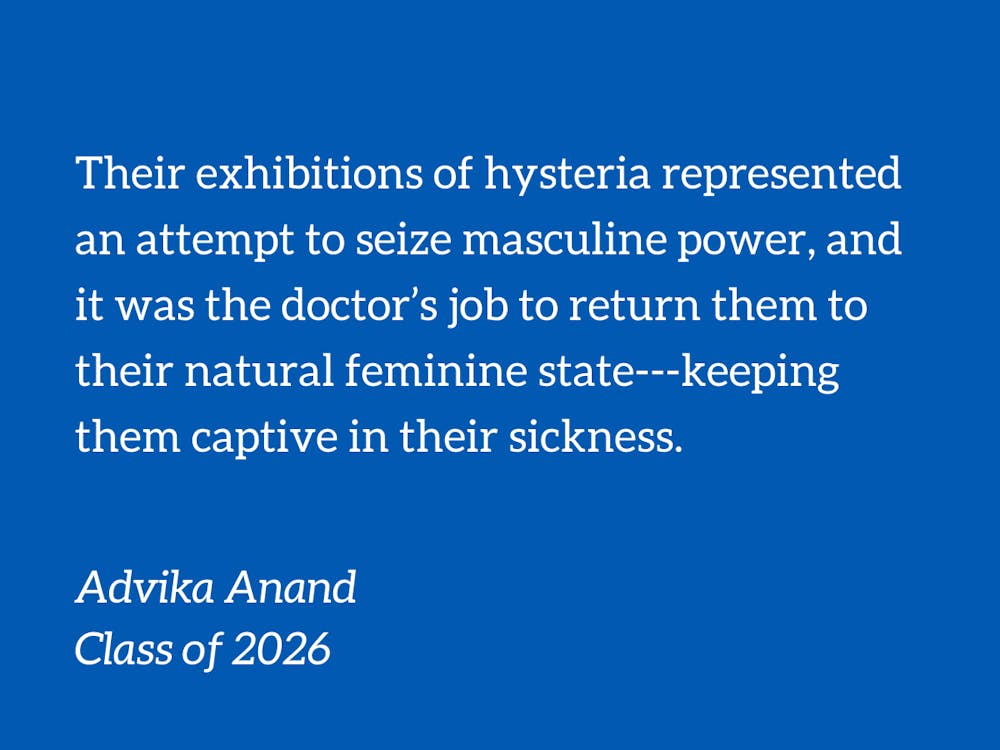Imagine being trapped among four walls closing in upon you. The walls are painted a dirty, sickly yellow. Fractals of sunlight filtered through splintered pieces of wood are your only remaining contact with the outside world. Such is the plight of the unnamed protagonist in Charlotte Perkins Gilman’s masterwork, “The Yellow Wallpaper.” Ambushed by her husband in a colonial mansion after the traumatic birth of their child, she is said to suffer from “nervous depression,” needing absolute rest to recover from her hysterical tendencies.
Traditional literary criticism posits that the protagonist goes insane at the story’s climax, citing her violent rubbing against the wallpaper while saying to her husband, “I’ve got out . . in spite of you.” But does she really lose her mind? Or does she simply become free? And why do contemporary associations correlate women’s liberation with absurdity?
The short story’s genius does not cease at its literary genius; instead, its plot serves as an early attempt to explore 19th-century conceptions of women’s hysteria. Women’s brains were seen as “silent, powerless, and passive,” and any mental exertion through intellectual stimulation would further stymy their feeble minds, which would then climax into a state of hysteria. Doctors were told to analyze women’s medical conditions through this lens, attributing them to a lack of self-control instead of a real medical emergency. Their exhibitions of hysteria represented an attempt to seize masculine power, and it was the doctor’s job to return them to their natural feminine state---keeping them captive in their sickness.
Although 19th-century gynecological treatment practices may have been phased out, the
misogynistic sentiments that bolstered them still loom large. Medical gaslighting strips women of necessary health care interventions on the daily, endangering their lives in the process.
Research has suggested that women are far more likely to be misdiagnosed than men overall. Other elements, such as books, TV shows, and movies, of popular culture also depict themes similar to those of “The Yellow Wallpaper.” Collectively, these works portray the search for accurate diagnoses as a state of psychosis. Thus, it is the diagnosis of hysteria itself that perpetuates the same “female madness” so feared by learned doctors.
These subconscious biases have palpable, devastating consequences. Studies conducted by Ana Mikolic with the Journal of Neurotrauma show that women are more likely to be treated “less aggressively” for traumatic brain injuries, presumably on account of their perceived “feebleness.” This quest to eliminate lingering feminine causes further leads to longer wait times for cancer and heart disease diagnoses.
The causes for these glaring treatment discrepancies are not due to time-consuming attempts of assessing the scope of the medical situation alone; an implicit psychological bias leads doctors and laypeople alike to blame women’s health care on a lack of self-care and mental weakness. Quite sadly, diagnoses of life-threatening conditions, such as anaphylactic shock, end up providing immense psychological relief by validating women’s distress and eliminating the fear that “it’s just a panic attack.” The misogynistic underpinnings of current medical treatments can be traced back to the early clinical trials of the 1970s. Women were excluded from these drug trials for fear of interfering with their fertility so medication efficacy was tested only on men, leading women to consume substances that did them more harm than good.
This vicious cycle of trivializing women’s pain is perpetuated through the normalization of crippling dysmenorrhea. “Normal period pain” is classified as moderate to severe on the universal pain assessment tool---the same as that of a broken leg. Reducing a woman’s pain to “period cramps” is common and can lead women to trivialize symptoms of more severe conditions such as endometriosis, ovarian cysts, and in some cases, early indicators of gynecological cancers.
At first glance, the deficiencies in feminine medical care appear to be so glaring that there appears to be very little we can do to reverse this harrowing trend. But making doctors aware of their implicit biases can heighten their sensitivity to their patients and lead them to devise more effective solutions to medical conditions. Health care is also a social science, and doctors-in-training must learn of the havoc gender biases can wreck on the continuum of care.
As Maya Angelou put it, we “are sick and tired of being sick and tired” because we know we are trapped by the yellow wallpaper. And the force that lingers below the floors, trying to break free, in spite of them, is us, and we will succeed because if we wish to live, we don’t have a choice.
Advikaa Anand is a Trinity freshman. Her columns run on alternate Thursdays.
Get The Chronicle straight to your inbox
Signup for our weekly newsletter. Cancel at any time.
Advikaa Anand is a Trinity sophomore and an opinion managing editor of The Chronicle's 119th volume.

